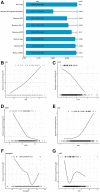Prediction models for major adverse cardiovascular events following ST-segment elevation myocardial infarction and subgroup-specific performance
- PMID: 37180806
- PMCID: PMC10167292
- DOI: 10.3389/fcvm.2023.1181424
Prediction models for major adverse cardiovascular events following ST-segment elevation myocardial infarction and subgroup-specific performance
Abstract
Background: ST-segment elevation myocardial infarction (STEMI) patients are at a high residual risk of major adverse cardiovascular events (MACEs) after revascularization. Risk factors modify prognostic risk in distinct ways in different STEMI subpopulations. We developed a MACEs prediction model in patients with STEMI and examined its performance across subgroups.
Methods: Machine-learning models based on 63 clinical features were trained in patients with STEMI who underwent PCI. The best-performing model (the iPROMPT score) was further validated in an external cohort. Its predictive value and variable contribution were studied in the entire population and subgroups.
Results: Over 2.56 and 2.84 years, 5.0% and 8.33% of patients experienced MACEs in the derivation and external validation cohorts, respectively. The iPROMPT score predictors were ST-segment deviation, brain natriuretic peptide (BNP), low-density lipoprotein cholesterol (LDL-C), estimated glomerular filtration rate (eGFR), age, hemoglobin, and white blood cell (WBC) count. The iPROMPT score improved the predictive value of the existing risk score, with an increase in the area under the curve to 0.837 [95% confidence interval (CI): 0.784-0.889] in the derivation cohort and 0.730 (95% CI: 0.293-1.162) in the external validation cohort. Comparable performance was observed between subgroups. The ST-segment deviation was the most important predictor, followed by LDL-C in hypertensive patients, BNP in males, WBC count in females with diabetes mellitus, and eGFR in patients without diabetes mellitus. Hemoglobin was the top predictor in non-hypertensive patients.
Conclusion: The iPROMPT score predicts long-term MACEs following STEMI and provides insights into the pathophysiological mechanisms for subgroup differences.
Keywords: GRACE score; ST-segment elevation myocardial infarction; diabetes mellitus; hypertension; machine learning; sex.
© 2023 Chen, Tan, Du, Li, Yuan, Ni, Wang and Du.
Conflict of interest statement
The authors declare that the research was conducted in the absence of any commercial or financial relationships that could be construed as a potential conflict of interest.
Figures




References
-
- Ibanez B, James S, Agewall S, Antunes MJ, Bucciarelli-Ducci C, Bueno H, et al. 2017 ESC guidelines for the management of acute myocardial infarction in patients presenting with ST-segment elevation: the task force for the management of acute myocardial infarction in patients presenting with ST-segment elevation of the European society of cardiology (ESC). Eur Heart J. (2018) 39(2):119–77. 10.1093/eurheartj/ehx393 - DOI - PubMed
LinkOut - more resources
Full Text Sources
Research Materials
Miscellaneous

